Business Economics Report: Analysis of Demand, Supply, and Theories
VerifiedAdded on 2023/01/12
|12
|3114
|88
Report
AI Summary
This business economics report delves into the core principles of demand and supply, essential concepts for understanding market dynamics. The report begins by explaining the law of demand, illustrating its inverse relationship with price and outlining factors influencing demand, such as consumer preferences, income levels, and prices of related goods. It then explores the law of supply, detailing how price changes affect the quantity supplied and identifying key factors like production costs, technology, and government policies. Furthermore, the report compares and contrasts emerging economic theories of the 20th and 21st centuries, specifically focusing on the nudge theory and neo-classical economics, and relates them to modern business practices. The analysis uses Lidl as a case study, applying these economic principles to the company's operations and strategic decision-making.
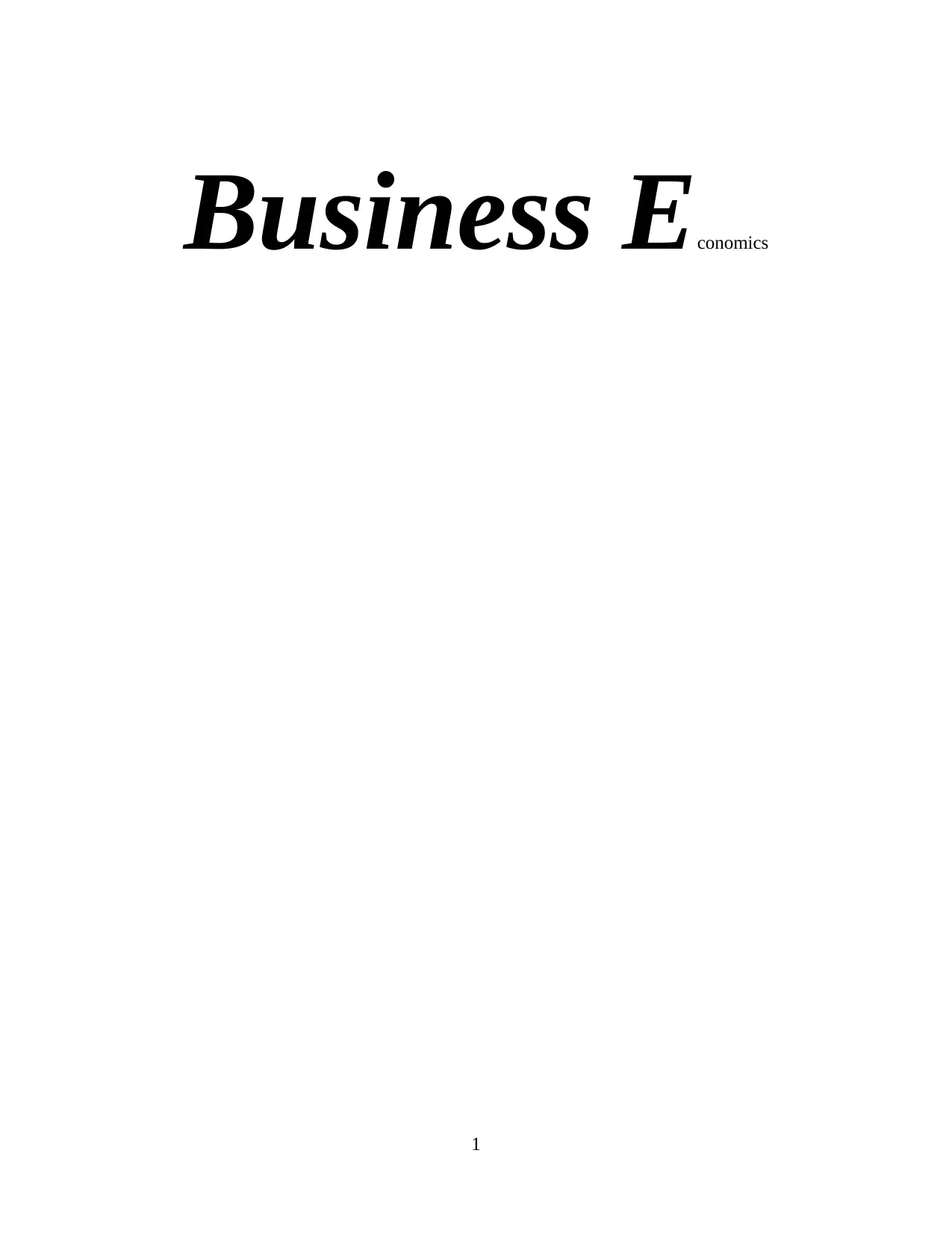
Business Economics
1
1
Paraphrase This Document
Need a fresh take? Get an instant paraphrase of this document with our AI Paraphraser
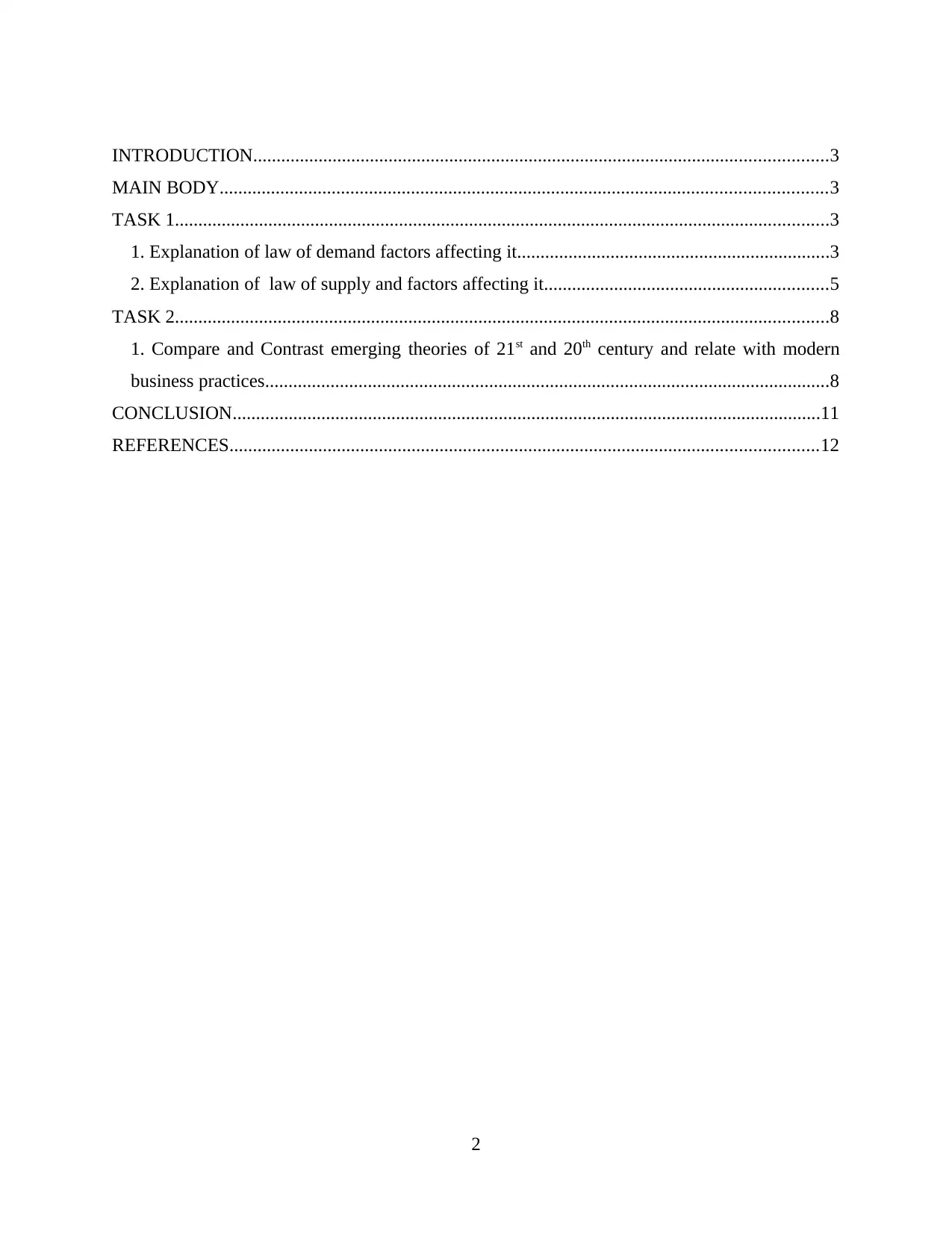
INTRODUCTION...........................................................................................................................3
MAIN BODY..................................................................................................................................3
TASK 1............................................................................................................................................3
1. Explanation of law of demand factors affecting it...................................................................3
2. Explanation of law of supply and factors affecting it.............................................................5
TASK 2............................................................................................................................................8
1. Compare and Contrast emerging theories of 21st and 20th century and relate with modern
business practices.........................................................................................................................8
CONCLUSION..............................................................................................................................11
REFERENCES..............................................................................................................................12
2
MAIN BODY..................................................................................................................................3
TASK 1............................................................................................................................................3
1. Explanation of law of demand factors affecting it...................................................................3
2. Explanation of law of supply and factors affecting it.............................................................5
TASK 2............................................................................................................................................8
1. Compare and Contrast emerging theories of 21st and 20th century and relate with modern
business practices.........................................................................................................................8
CONCLUSION..............................................................................................................................11
REFERENCES..............................................................................................................................12
2
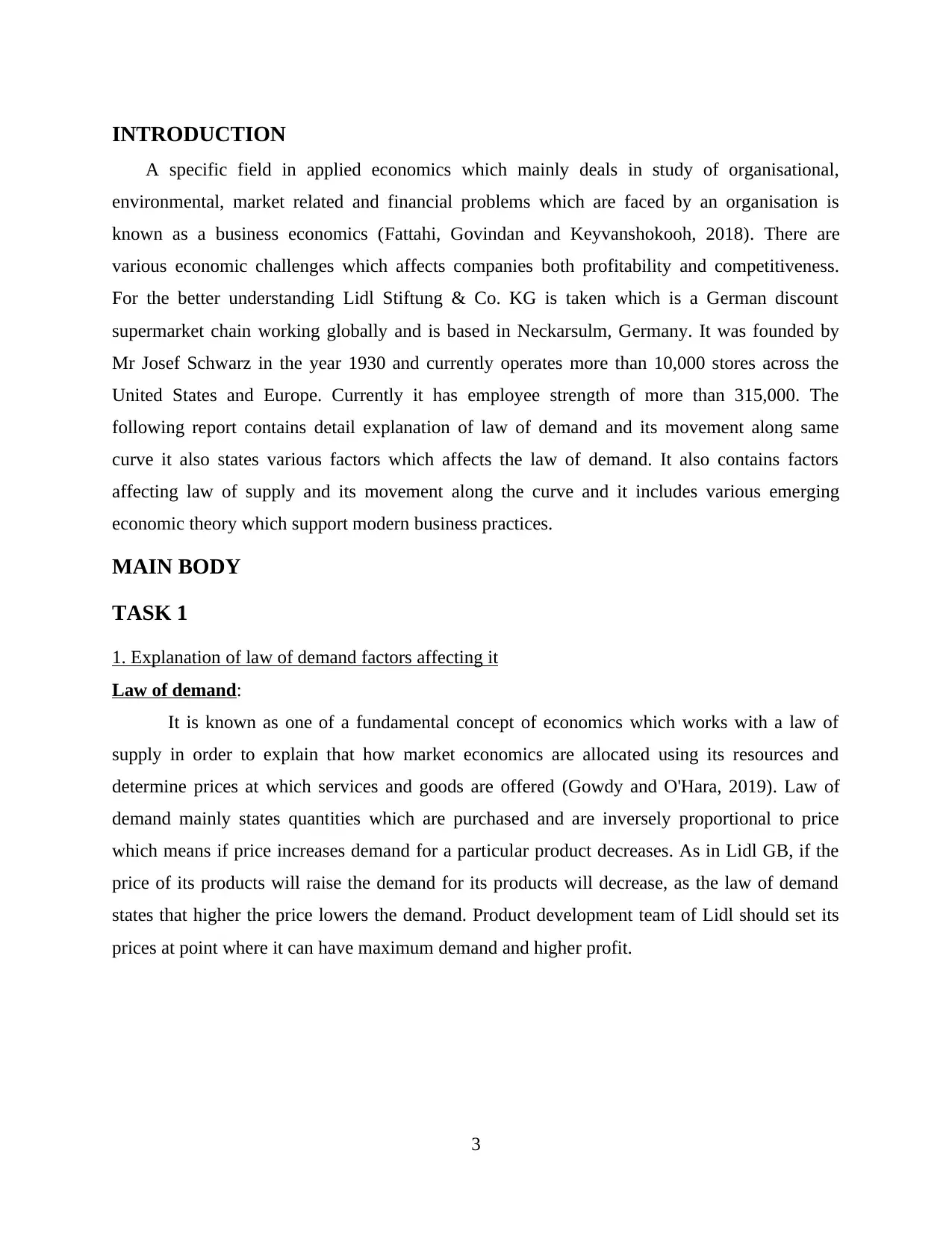
INTRODUCTION
A specific field in applied economics which mainly deals in study of organisational,
environmental, market related and financial problems which are faced by an organisation is
known as a business economics (Fattahi, Govindan and Keyvanshokooh, 2018). There are
various economic challenges which affects companies both profitability and competitiveness.
For the better understanding Lidl Stiftung & Co. KG is taken which is a German discount
supermarket chain working globally and is based in Neckarsulm, Germany. It was founded by
Mr Josef Schwarz in the year 1930 and currently operates more than 10,000 stores across the
United States and Europe. Currently it has employee strength of more than 315,000. The
following report contains detail explanation of law of demand and its movement along same
curve it also states various factors which affects the law of demand. It also contains factors
affecting law of supply and its movement along the curve and it includes various emerging
economic theory which support modern business practices.
MAIN BODY
TASK 1
1. Explanation of law of demand factors affecting it
Law of demand:
It is known as one of a fundamental concept of economics which works with a law of
supply in order to explain that how market economics are allocated using its resources and
determine prices at which services and goods are offered (Gowdy and O'Hara, 2019). Law of
demand mainly states quantities which are purchased and are inversely proportional to price
which means if price increases demand for a particular product decreases. As in Lidl GB, if the
price of its products will raise the demand for its products will decrease, as the law of demand
states that higher the price lowers the demand. Product development team of Lidl should set its
prices at point where it can have maximum demand and higher profit.
3
A specific field in applied economics which mainly deals in study of organisational,
environmental, market related and financial problems which are faced by an organisation is
known as a business economics (Fattahi, Govindan and Keyvanshokooh, 2018). There are
various economic challenges which affects companies both profitability and competitiveness.
For the better understanding Lidl Stiftung & Co. KG is taken which is a German discount
supermarket chain working globally and is based in Neckarsulm, Germany. It was founded by
Mr Josef Schwarz in the year 1930 and currently operates more than 10,000 stores across the
United States and Europe. Currently it has employee strength of more than 315,000. The
following report contains detail explanation of law of demand and its movement along same
curve it also states various factors which affects the law of demand. It also contains factors
affecting law of supply and its movement along the curve and it includes various emerging
economic theory which support modern business practices.
MAIN BODY
TASK 1
1. Explanation of law of demand factors affecting it
Law of demand:
It is known as one of a fundamental concept of economics which works with a law of
supply in order to explain that how market economics are allocated using its resources and
determine prices at which services and goods are offered (Gowdy and O'Hara, 2019). Law of
demand mainly states quantities which are purchased and are inversely proportional to price
which means if price increases demand for a particular product decreases. As in Lidl GB, if the
price of its products will raise the demand for its products will decrease, as the law of demand
states that higher the price lowers the demand. Product development team of Lidl should set its
prices at point where it can have maximum demand and higher profit.
3
⊘ This is a preview!⊘
Do you want full access?
Subscribe today to unlock all pages.

Trusted by 1+ million students worldwide
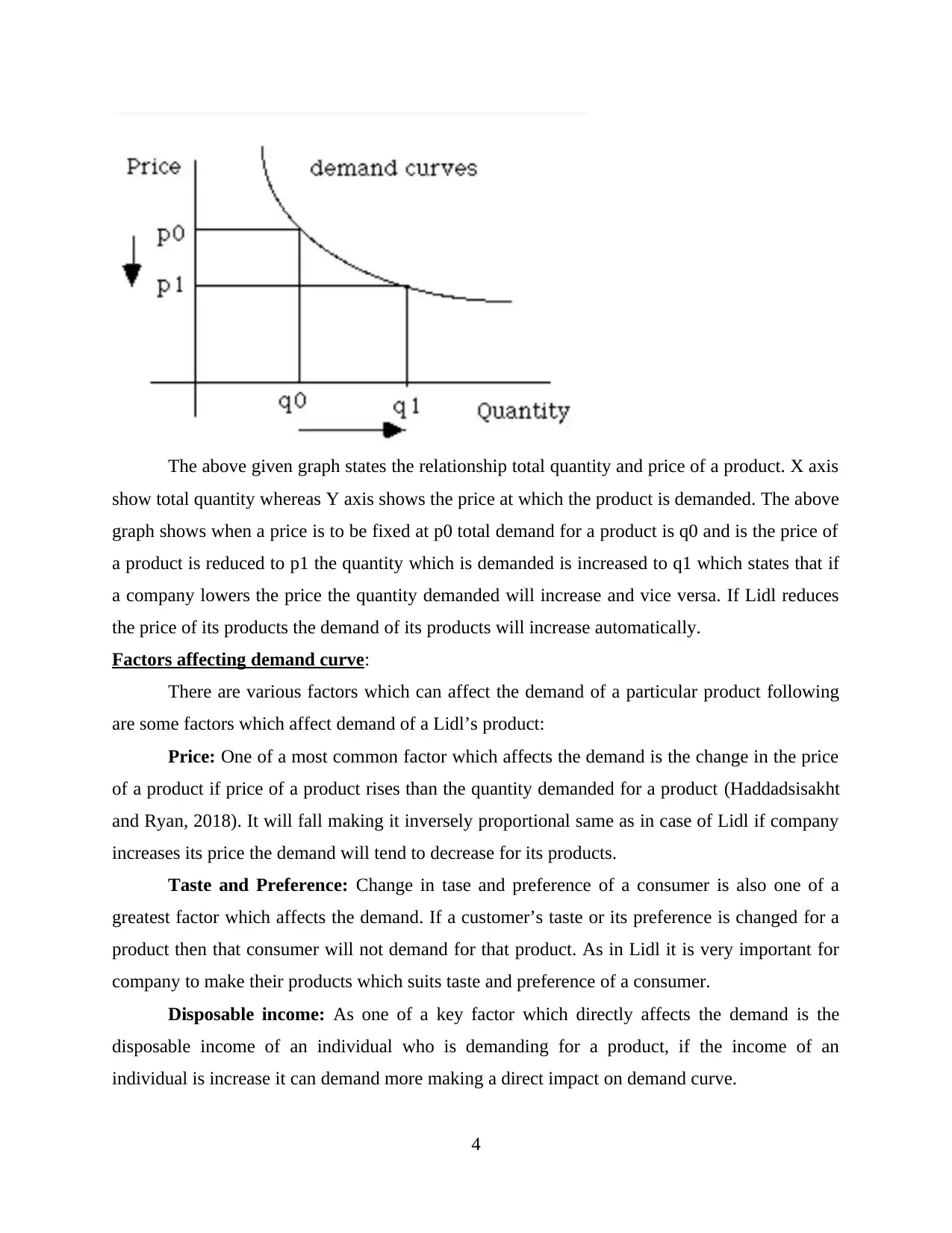
The above given graph states the relationship total quantity and price of a product. X axis
show total quantity whereas Y axis shows the price at which the product is demanded. The above
graph shows when a price is to be fixed at p0 total demand for a product is q0 and is the price of
a product is reduced to p1 the quantity which is demanded is increased to q1 which states that if
a company lowers the price the quantity demanded will increase and vice versa. If Lidl reduces
the price of its products the demand of its products will increase automatically.
Factors affecting demand curve:
There are various factors which can affect the demand of a particular product following
are some factors which affect demand of a Lidl’s product:
Price: One of a most common factor which affects the demand is the change in the price
of a product if price of a product rises than the quantity demanded for a product (Haddadsisakht
and Ryan, 2018). It will fall making it inversely proportional same as in case of Lidl if company
increases its price the demand will tend to decrease for its products.
Taste and Preference: Change in tase and preference of a consumer is also one of a
greatest factor which affects the demand. If a customer’s taste or its preference is changed for a
product then that consumer will not demand for that product. As in Lidl it is very important for
company to make their products which suits taste and preference of a consumer.
Disposable income: As one of a key factor which directly affects the demand is the
disposable income of an individual who is demanding for a product, if the income of an
individual is increase it can demand more making a direct impact on demand curve.
4
show total quantity whereas Y axis shows the price at which the product is demanded. The above
graph shows when a price is to be fixed at p0 total demand for a product is q0 and is the price of
a product is reduced to p1 the quantity which is demanded is increased to q1 which states that if
a company lowers the price the quantity demanded will increase and vice versa. If Lidl reduces
the price of its products the demand of its products will increase automatically.
Factors affecting demand curve:
There are various factors which can affect the demand of a particular product following
are some factors which affect demand of a Lidl’s product:
Price: One of a most common factor which affects the demand is the change in the price
of a product if price of a product rises than the quantity demanded for a product (Haddadsisakht
and Ryan, 2018). It will fall making it inversely proportional same as in case of Lidl if company
increases its price the demand will tend to decrease for its products.
Taste and Preference: Change in tase and preference of a consumer is also one of a
greatest factor which affects the demand. If a customer’s taste or its preference is changed for a
product then that consumer will not demand for that product. As in Lidl it is very important for
company to make their products which suits taste and preference of a consumer.
Disposable income: As one of a key factor which directly affects the demand is the
disposable income of an individual who is demanding for a product, if the income of an
individual is increase it can demand more making a direct impact on demand curve.
4
Paraphrase This Document
Need a fresh take? Get an instant paraphrase of this document with our AI Paraphraser
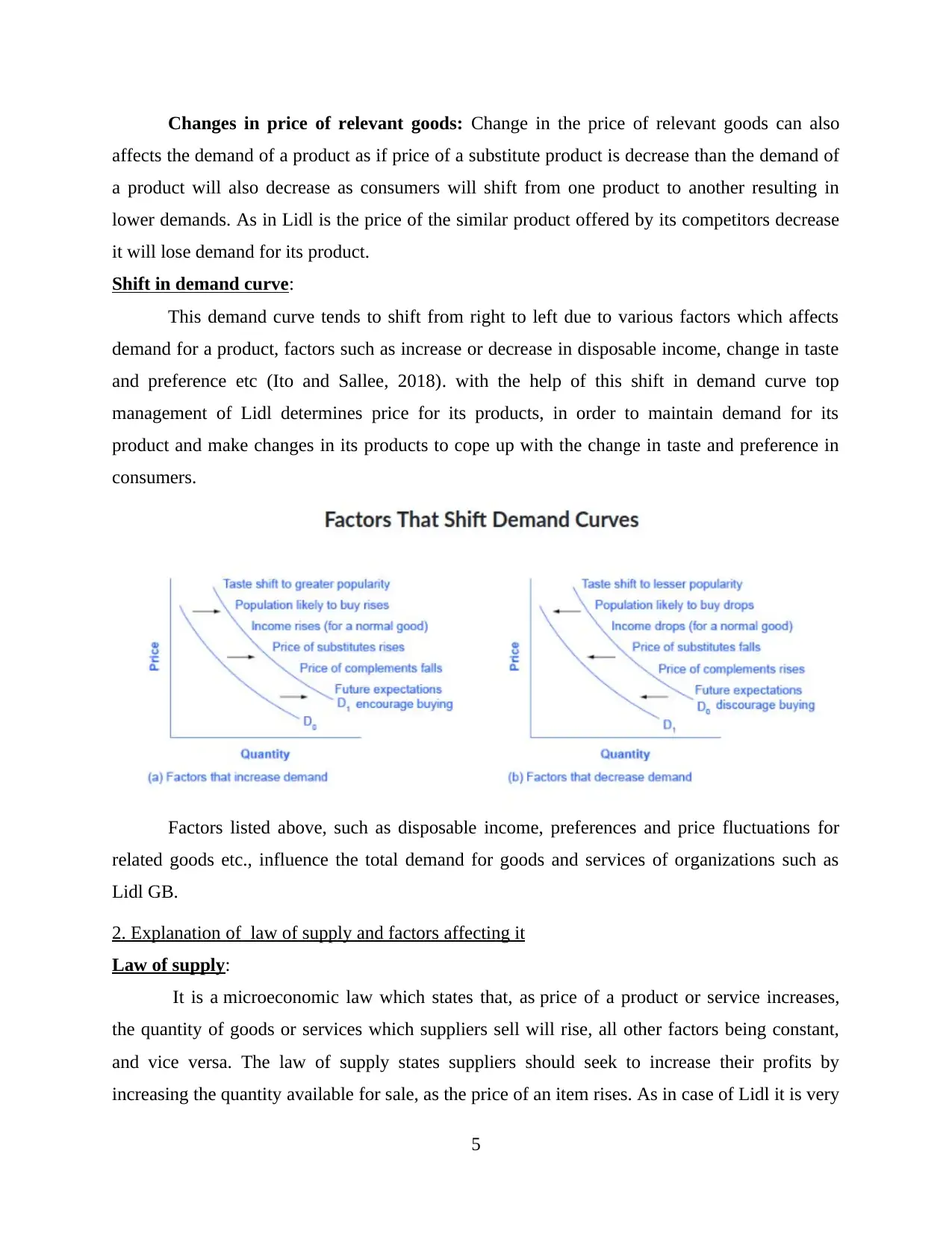
Changes in price of relevant goods: Change in the price of relevant goods can also
affects the demand of a product as if price of a substitute product is decrease than the demand of
a product will also decrease as consumers will shift from one product to another resulting in
lower demands. As in Lidl is the price of the similar product offered by its competitors decrease
it will lose demand for its product.
Shift in demand curve:
This demand curve tends to shift from right to left due to various factors which affects
demand for a product, factors such as increase or decrease in disposable income, change in taste
and preference etc (Ito and Sallee, 2018). with the help of this shift in demand curve top
management of Lidl determines price for its products, in order to maintain demand for its
product and make changes in its products to cope up with the change in taste and preference in
consumers.
Factors listed above, such as disposable income, preferences and price fluctuations for
related goods etc., influence the total demand for goods and services of organizations such as
Lidl GB.
2. Explanation of law of supply and factors affecting it
Law of supply:
It is a microeconomic law which states that, as price of a product or service increases,
the quantity of goods or services which suppliers sell will rise, all other factors being constant,
and vice versa. The law of supply states suppliers should seek to increase their profits by
increasing the quantity available for sale, as the price of an item rises. As in case of Lidl it is very
5
affects the demand of a product as if price of a substitute product is decrease than the demand of
a product will also decrease as consumers will shift from one product to another resulting in
lower demands. As in Lidl is the price of the similar product offered by its competitors decrease
it will lose demand for its product.
Shift in demand curve:
This demand curve tends to shift from right to left due to various factors which affects
demand for a product, factors such as increase or decrease in disposable income, change in taste
and preference etc (Ito and Sallee, 2018). with the help of this shift in demand curve top
management of Lidl determines price for its products, in order to maintain demand for its
product and make changes in its products to cope up with the change in taste and preference in
consumers.
Factors listed above, such as disposable income, preferences and price fluctuations for
related goods etc., influence the total demand for goods and services of organizations such as
Lidl GB.
2. Explanation of law of supply and factors affecting it
Law of supply:
It is a microeconomic law which states that, as price of a product or service increases,
the quantity of goods or services which suppliers sell will rise, all other factors being constant,
and vice versa. The law of supply states suppliers should seek to increase their profits by
increasing the quantity available for sale, as the price of an item rises. As in case of Lidl it is very
5
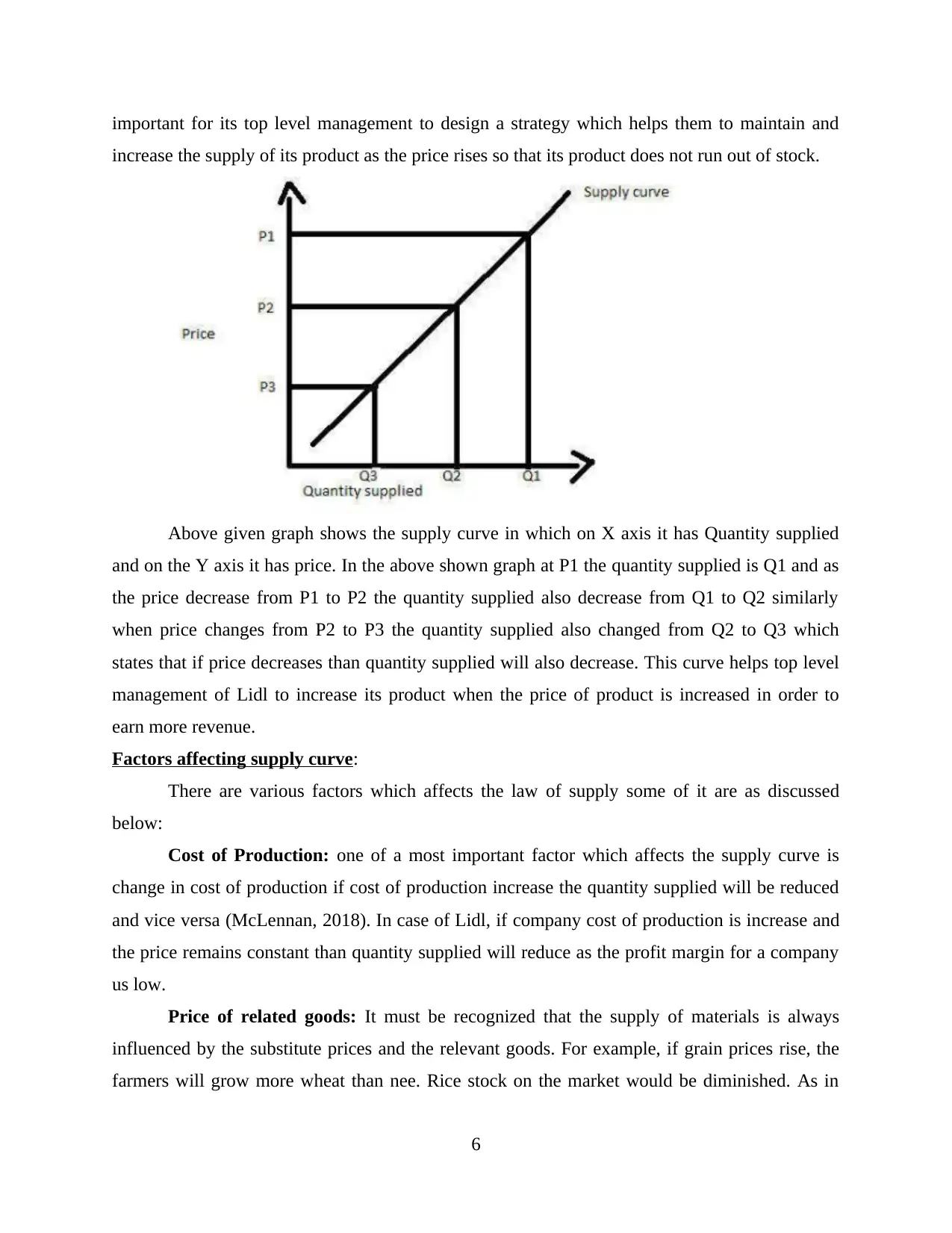
important for its top level management to design a strategy which helps them to maintain and
increase the supply of its product as the price rises so that its product does not run out of stock.
Above given graph shows the supply curve in which on X axis it has Quantity supplied
and on the Y axis it has price. In the above shown graph at P1 the quantity supplied is Q1 and as
the price decrease from P1 to P2 the quantity supplied also decrease from Q1 to Q2 similarly
when price changes from P2 to P3 the quantity supplied also changed from Q2 to Q3 which
states that if price decreases than quantity supplied will also decrease. This curve helps top level
management of Lidl to increase its product when the price of product is increased in order to
earn more revenue.
Factors affecting supply curve:
There are various factors which affects the law of supply some of it are as discussed
below:
Cost of Production: one of a most important factor which affects the supply curve is
change in cost of production if cost of production increase the quantity supplied will be reduced
and vice versa (McLennan, 2018). In case of Lidl, if company cost of production is increase and
the price remains constant than quantity supplied will reduce as the profit margin for a company
us low.
Price of related goods: It must be recognized that the supply of materials is always
influenced by the substitute prices and the relevant goods. For example, if grain prices rise, the
farmers will grow more wheat than nee. Rice stock on the market would be diminished. As in
6
increase the supply of its product as the price rises so that its product does not run out of stock.
Above given graph shows the supply curve in which on X axis it has Quantity supplied
and on the Y axis it has price. In the above shown graph at P1 the quantity supplied is Q1 and as
the price decrease from P1 to P2 the quantity supplied also decrease from Q1 to Q2 similarly
when price changes from P2 to P3 the quantity supplied also changed from Q2 to Q3 which
states that if price decreases than quantity supplied will also decrease. This curve helps top level
management of Lidl to increase its product when the price of product is increased in order to
earn more revenue.
Factors affecting supply curve:
There are various factors which affects the law of supply some of it are as discussed
below:
Cost of Production: one of a most important factor which affects the supply curve is
change in cost of production if cost of production increase the quantity supplied will be reduced
and vice versa (McLennan, 2018). In case of Lidl, if company cost of production is increase and
the price remains constant than quantity supplied will reduce as the profit margin for a company
us low.
Price of related goods: It must be recognized that the supply of materials is always
influenced by the substitute prices and the relevant goods. For example, if grain prices rise, the
farmers will grow more wheat than nee. Rice stock on the market would be diminished. As in
6
⊘ This is a preview!⊘
Do you want full access?
Subscribe today to unlock all pages.

Trusted by 1+ million students worldwide
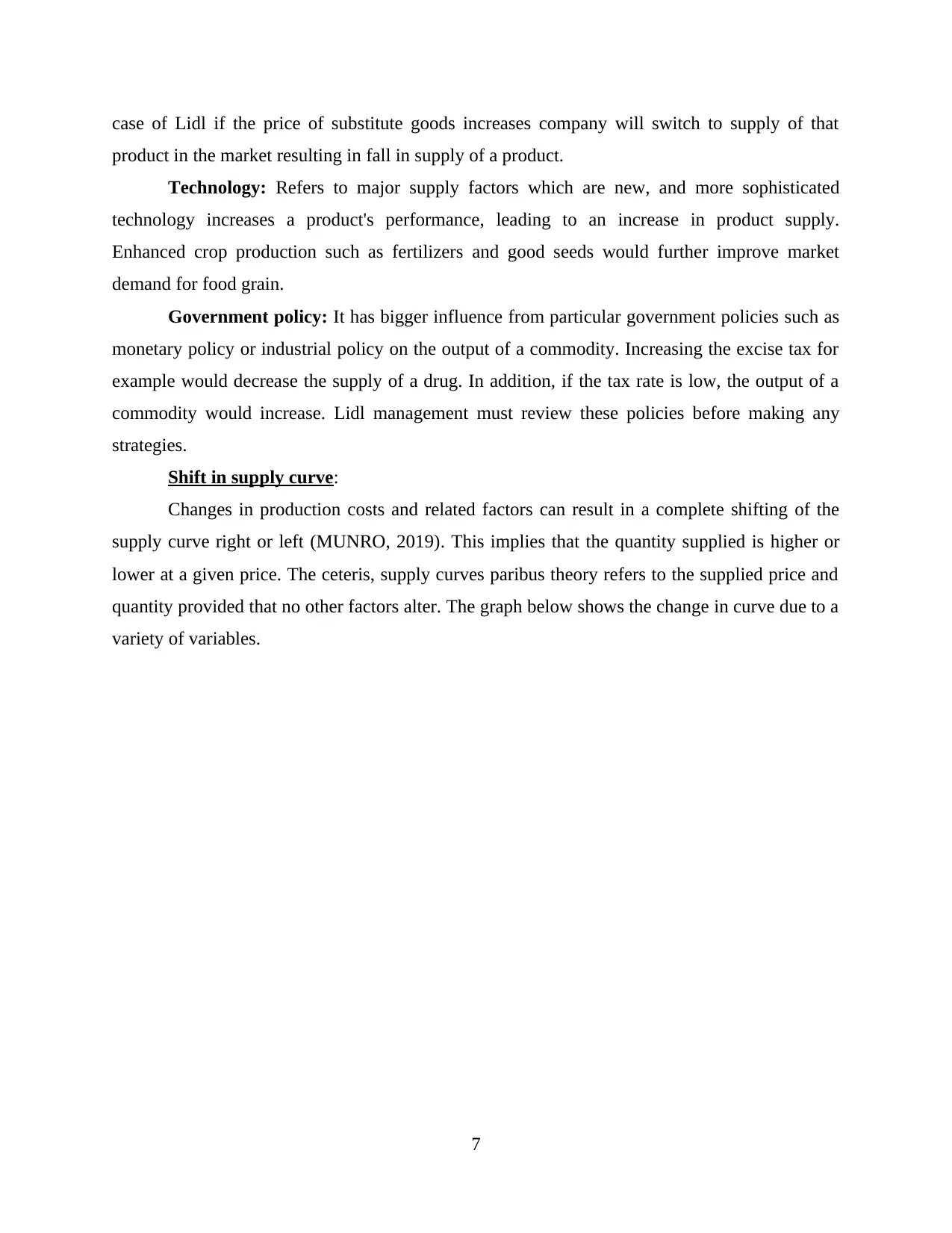
case of Lidl if the price of substitute goods increases company will switch to supply of that
product in the market resulting in fall in supply of a product.
Technology: Refers to major supply factors which are new, and more sophisticated
technology increases a product's performance, leading to an increase in product supply.
Enhanced crop production such as fertilizers and good seeds would further improve market
demand for food grain.
Government policy: It has bigger influence from particular government policies such as
monetary policy or industrial policy on the output of a commodity. Increasing the excise tax for
example would decrease the supply of a drug. In addition, if the tax rate is low, the output of a
commodity would increase. Lidl management must review these policies before making any
strategies.
Shift in supply curve:
Changes in production costs and related factors can result in a complete shifting of the
supply curve right or left (MUNRO, 2019). This implies that the quantity supplied is higher or
lower at a given price. The ceteris, supply curves paribus theory refers to the supplied price and
quantity provided that no other factors alter. The graph below shows the change in curve due to a
variety of variables.
7
product in the market resulting in fall in supply of a product.
Technology: Refers to major supply factors which are new, and more sophisticated
technology increases a product's performance, leading to an increase in product supply.
Enhanced crop production such as fertilizers and good seeds would further improve market
demand for food grain.
Government policy: It has bigger influence from particular government policies such as
monetary policy or industrial policy on the output of a commodity. Increasing the excise tax for
example would decrease the supply of a drug. In addition, if the tax rate is low, the output of a
commodity would increase. Lidl management must review these policies before making any
strategies.
Shift in supply curve:
Changes in production costs and related factors can result in a complete shifting of the
supply curve right or left (MUNRO, 2019). This implies that the quantity supplied is higher or
lower at a given price. The ceteris, supply curves paribus theory refers to the supplied price and
quantity provided that no other factors alter. The graph below shows the change in curve due to a
variety of variables.
7
Paraphrase This Document
Need a fresh take? Get an instant paraphrase of this document with our AI Paraphraser
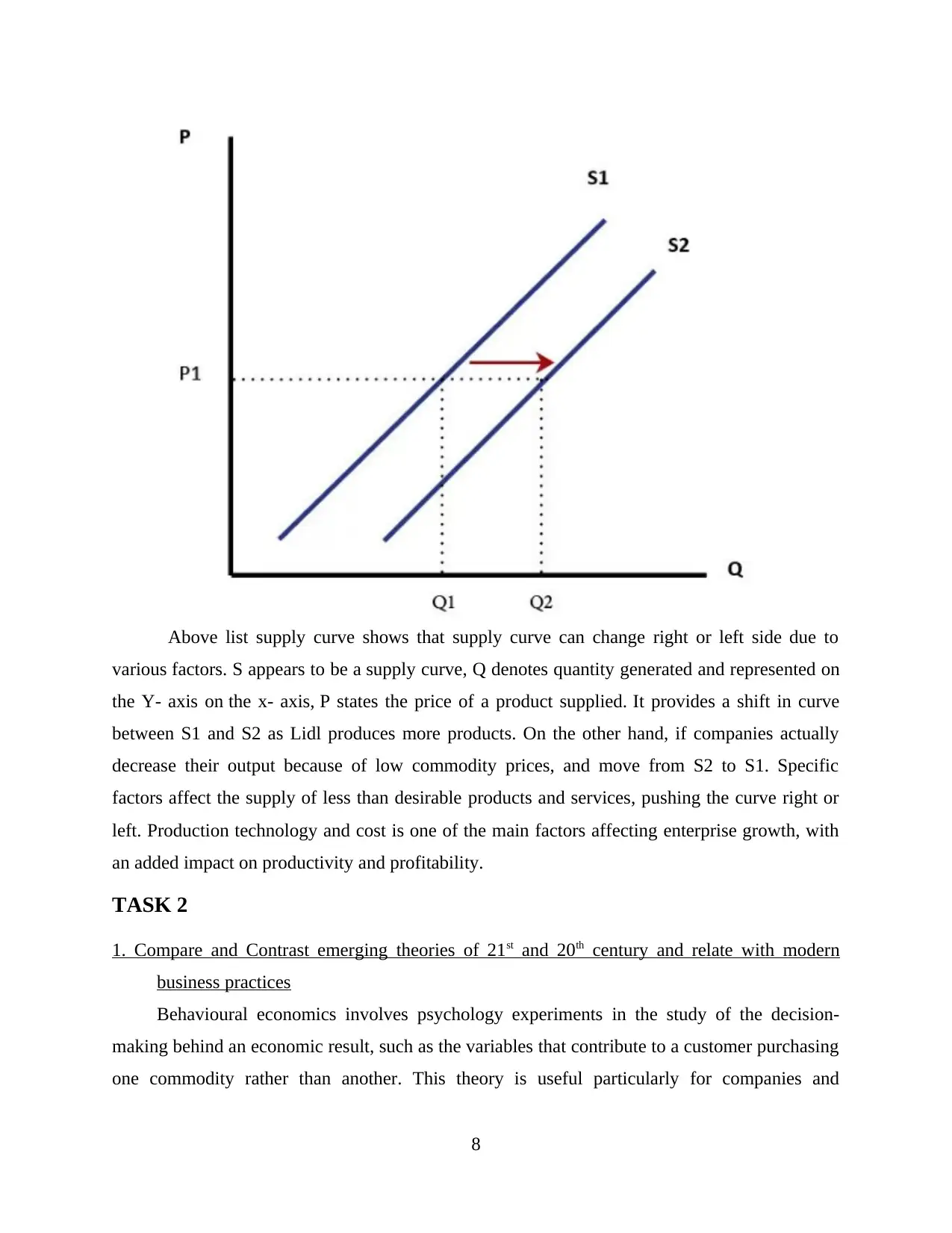
Above list supply curve shows that supply curve can change right or left side due to
various factors. S appears to be a supply curve, Q denotes quantity generated and represented on
the Y- axis on the x- axis, P states the price of a product supplied. It provides a shift in curve
between S1 and S2 as Lidl produces more products. On the other hand, if companies actually
decrease their output because of low commodity prices, and move from S2 to S1. Specific
factors affect the supply of less than desirable products and services, pushing the curve right or
left. Production technology and cost is one of the main factors affecting enterprise growth, with
an added impact on productivity and profitability.
TASK 2
1. Compare and Contrast emerging theories of 21st and 20th century and relate with modern
business practices
Behavioural economics involves psychology experiments in the study of the decision-
making behind an economic result, such as the variables that contribute to a customer purchasing
one commodity rather than another. This theory is useful particularly for companies and
8
various factors. S appears to be a supply curve, Q denotes quantity generated and represented on
the Y- axis on the x- axis, P states the price of a product supplied. It provides a shift in curve
between S1 and S2 as Lidl produces more products. On the other hand, if companies actually
decrease their output because of low commodity prices, and move from S2 to S1. Specific
factors affect the supply of less than desirable products and services, pushing the curve right or
left. Production technology and cost is one of the main factors affecting enterprise growth, with
an added impact on productivity and profitability.
TASK 2
1. Compare and Contrast emerging theories of 21st and 20th century and relate with modern
business practices
Behavioural economics involves psychology experiments in the study of the decision-
making behind an economic result, such as the variables that contribute to a customer purchasing
one commodity rather than another. This theory is useful particularly for companies and
8
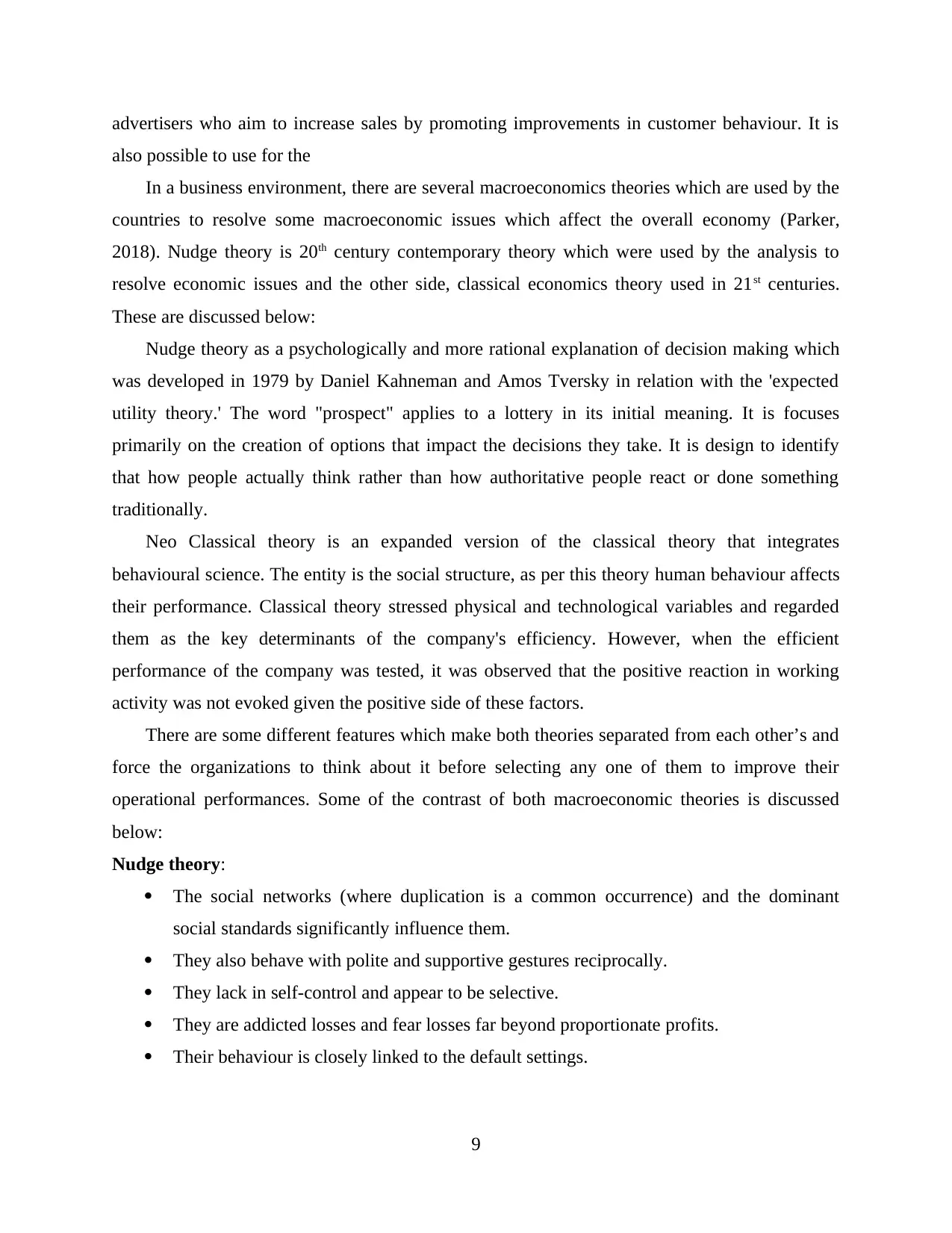
advertisers who aim to increase sales by promoting improvements in customer behaviour. It is
also possible to use for the
In a business environment, there are several macroeconomics theories which are used by the
countries to resolve some macroeconomic issues which affect the overall economy (Parker,
2018). Nudge theory is 20th century contemporary theory which were used by the analysis to
resolve economic issues and the other side, classical economics theory used in 21st centuries.
These are discussed below:
Nudge theory as a psychologically and more rational explanation of decision making which
was developed in 1979 by Daniel Kahneman and Amos Tversky in relation with the 'expected
utility theory.' The word "prospect" applies to a lottery in its initial meaning. It is focuses
primarily on the creation of options that impact the decisions they take. It is design to identify
that how people actually think rather than how authoritative people react or done something
traditionally.
Neo Classical theory is an expanded version of the classical theory that integrates
behavioural science. The entity is the social structure, as per this theory human behaviour affects
their performance. Classical theory stressed physical and technological variables and regarded
them as the key determinants of the company's efficiency. However, when the efficient
performance of the company was tested, it was observed that the positive reaction in working
activity was not evoked given the positive side of these factors.
There are some different features which make both theories separated from each other’s and
force the organizations to think about it before selecting any one of them to improve their
operational performances. Some of the contrast of both macroeconomic theories is discussed
below:
Nudge theory:
The social networks (where duplication is a common occurrence) and the dominant
social standards significantly influence them.
They also behave with polite and supportive gestures reciprocally.
They lack in self-control and appear to be selective.
They are addicted losses and fear losses far beyond proportionate profits.
Their behaviour is closely linked to the default settings.
9
also possible to use for the
In a business environment, there are several macroeconomics theories which are used by the
countries to resolve some macroeconomic issues which affect the overall economy (Parker,
2018). Nudge theory is 20th century contemporary theory which were used by the analysis to
resolve economic issues and the other side, classical economics theory used in 21st centuries.
These are discussed below:
Nudge theory as a psychologically and more rational explanation of decision making which
was developed in 1979 by Daniel Kahneman and Amos Tversky in relation with the 'expected
utility theory.' The word "prospect" applies to a lottery in its initial meaning. It is focuses
primarily on the creation of options that impact the decisions they take. It is design to identify
that how people actually think rather than how authoritative people react or done something
traditionally.
Neo Classical theory is an expanded version of the classical theory that integrates
behavioural science. The entity is the social structure, as per this theory human behaviour affects
their performance. Classical theory stressed physical and technological variables and regarded
them as the key determinants of the company's efficiency. However, when the efficient
performance of the company was tested, it was observed that the positive reaction in working
activity was not evoked given the positive side of these factors.
There are some different features which make both theories separated from each other’s and
force the organizations to think about it before selecting any one of them to improve their
operational performances. Some of the contrast of both macroeconomic theories is discussed
below:
Nudge theory:
The social networks (where duplication is a common occurrence) and the dominant
social standards significantly influence them.
They also behave with polite and supportive gestures reciprocally.
They lack in self-control and appear to be selective.
They are addicted losses and fear losses far beyond proportionate profits.
Their behaviour is closely linked to the default settings.
9
⊘ This is a preview!⊘
Do you want full access?
Subscribe today to unlock all pages.

Trusted by 1+ million students worldwide
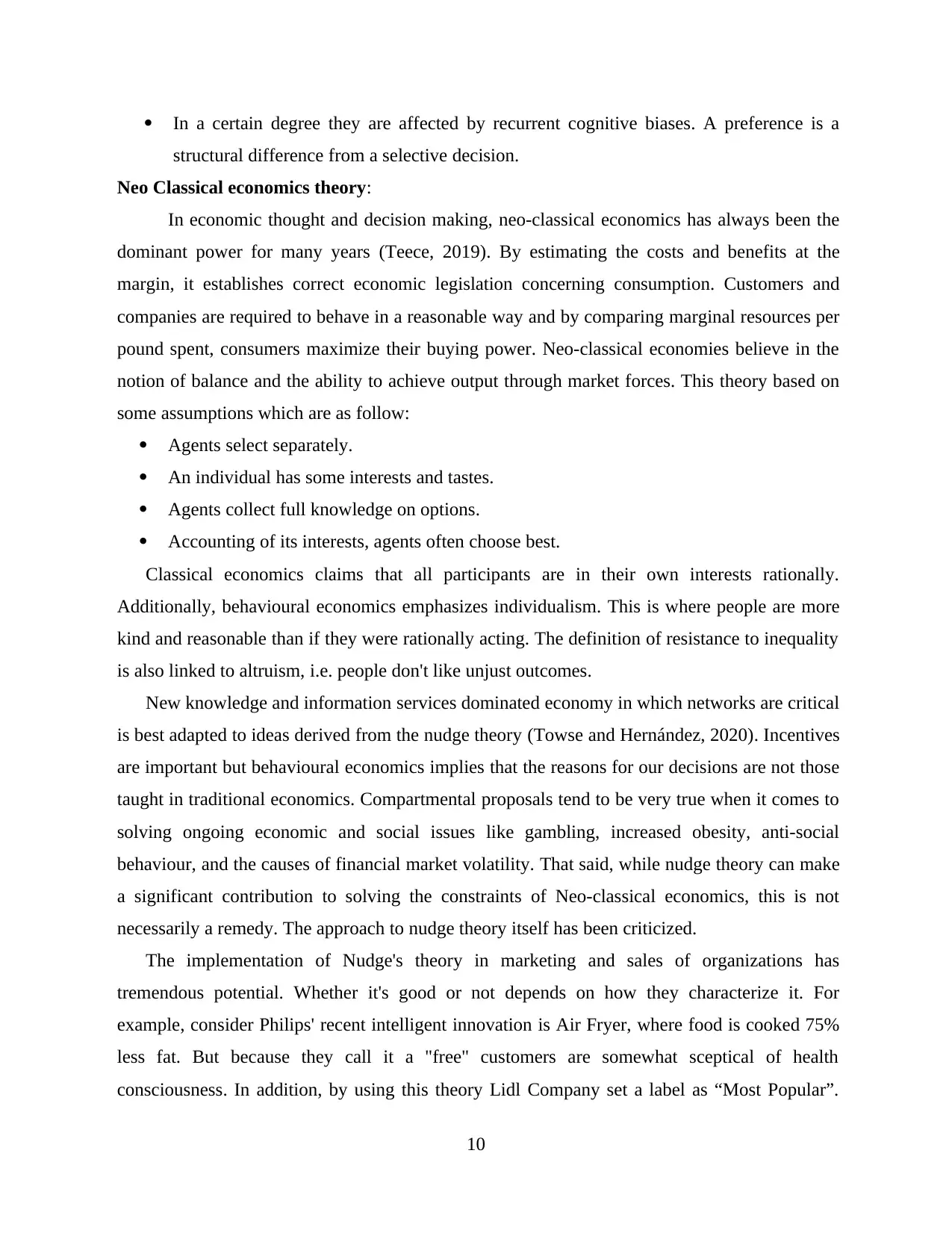
In a certain degree they are affected by recurrent cognitive biases. A preference is a
structural difference from a selective decision.
Neo Classical economics theory:
In economic thought and decision making, neo-classical economics has always been the
dominant power for many years (Teece, 2019). By estimating the costs and benefits at the
margin, it establishes correct economic legislation concerning consumption. Customers and
companies are required to behave in a reasonable way and by comparing marginal resources per
pound spent, consumers maximize their buying power. Neo-classical economies believe in the
notion of balance and the ability to achieve output through market forces. This theory based on
some assumptions which are as follow:
Agents select separately.
An individual has some interests and tastes.
Agents collect full knowledge on options.
Accounting of its interests, agents often choose best.
Classical economics claims that all participants are in their own interests rationally.
Additionally, behavioural economics emphasizes individualism. This is where people are more
kind and reasonable than if they were rationally acting. The definition of resistance to inequality
is also linked to altruism, i.e. people don't like unjust outcomes.
New knowledge and information services dominated economy in which networks are critical
is best adapted to ideas derived from the nudge theory (Towse and Hernández, 2020). Incentives
are important but behavioural economics implies that the reasons for our decisions are not those
taught in traditional economics. Compartmental proposals tend to be very true when it comes to
solving ongoing economic and social issues like gambling, increased obesity, anti-social
behaviour, and the causes of financial market volatility. That said, while nudge theory can make
a significant contribution to solving the constraints of Neo-classical economics, this is not
necessarily a remedy. The approach to nudge theory itself has been criticized.
The implementation of Nudge's theory in marketing and sales of organizations has
tremendous potential. Whether it's good or not depends on how they characterize it. For
example, consider Philips' recent intelligent innovation is Air Fryer, where food is cooked 75%
less fat. But because they call it a "free" customers are somewhat sceptical of health
consciousness. In addition, by using this theory Lidl Company set a label as “Most Popular”.
10
structural difference from a selective decision.
Neo Classical economics theory:
In economic thought and decision making, neo-classical economics has always been the
dominant power for many years (Teece, 2019). By estimating the costs and benefits at the
margin, it establishes correct economic legislation concerning consumption. Customers and
companies are required to behave in a reasonable way and by comparing marginal resources per
pound spent, consumers maximize their buying power. Neo-classical economies believe in the
notion of balance and the ability to achieve output through market forces. This theory based on
some assumptions which are as follow:
Agents select separately.
An individual has some interests and tastes.
Agents collect full knowledge on options.
Accounting of its interests, agents often choose best.
Classical economics claims that all participants are in their own interests rationally.
Additionally, behavioural economics emphasizes individualism. This is where people are more
kind and reasonable than if they were rationally acting. The definition of resistance to inequality
is also linked to altruism, i.e. people don't like unjust outcomes.
New knowledge and information services dominated economy in which networks are critical
is best adapted to ideas derived from the nudge theory (Towse and Hernández, 2020). Incentives
are important but behavioural economics implies that the reasons for our decisions are not those
taught in traditional economics. Compartmental proposals tend to be very true when it comes to
solving ongoing economic and social issues like gambling, increased obesity, anti-social
behaviour, and the causes of financial market volatility. That said, while nudge theory can make
a significant contribution to solving the constraints of Neo-classical economics, this is not
necessarily a remedy. The approach to nudge theory itself has been criticized.
The implementation of Nudge's theory in marketing and sales of organizations has
tremendous potential. Whether it's good or not depends on how they characterize it. For
example, consider Philips' recent intelligent innovation is Air Fryer, where food is cooked 75%
less fat. But because they call it a "free" customers are somewhat sceptical of health
consciousness. In addition, by using this theory Lidl Company set a label as “Most Popular”.
10
Paraphrase This Document
Need a fresh take? Get an instant paraphrase of this document with our AI Paraphraser
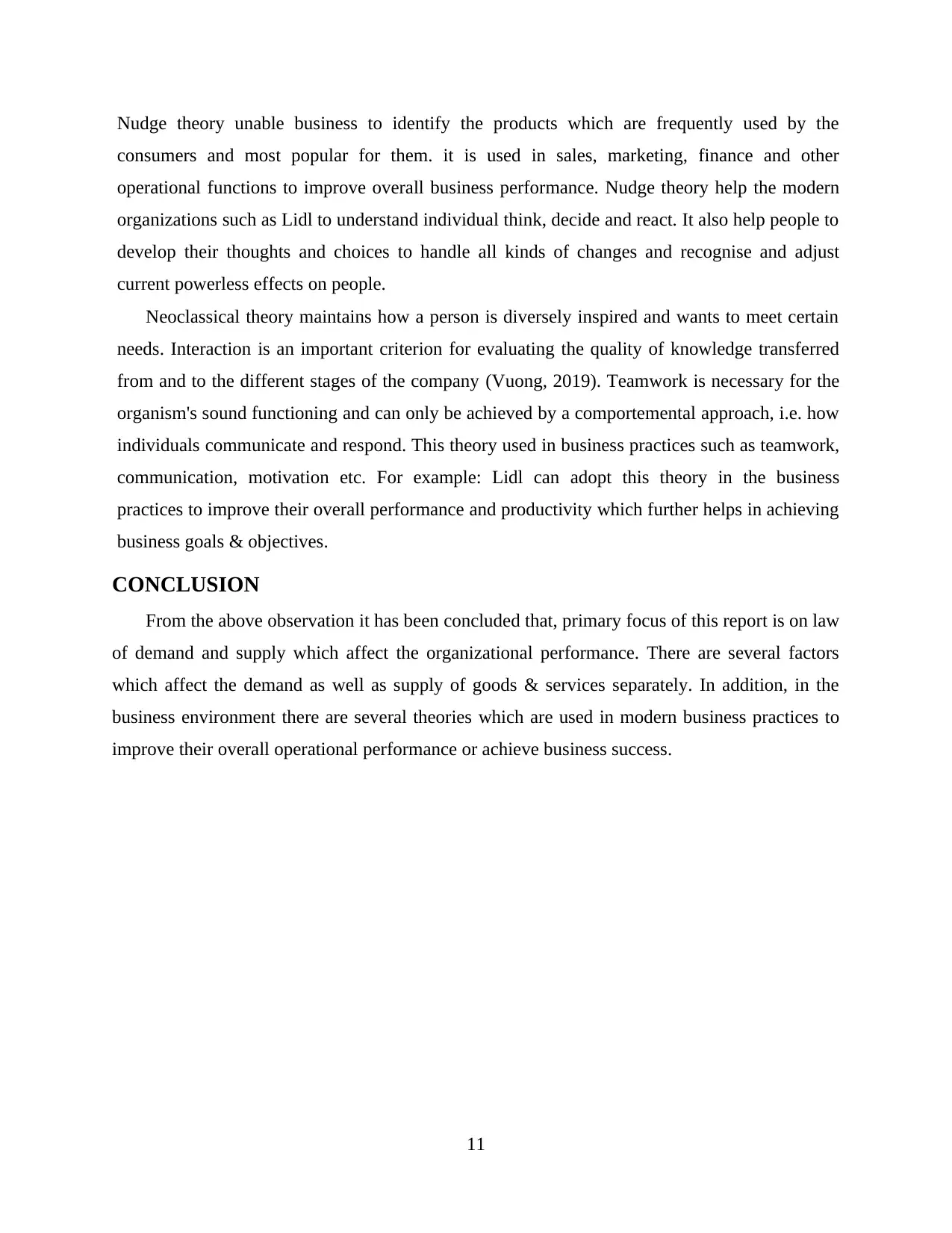
Nudge theory unable business to identify the products which are frequently used by the
consumers and most popular for them. it is used in sales, marketing, finance and other
operational functions to improve overall business performance. Nudge theory help the modern
organizations such as Lidl to understand individual think, decide and react. It also help people to
develop their thoughts and choices to handle all kinds of changes and recognise and adjust
current powerless effects on people.
Neoclassical theory maintains how a person is diversely inspired and wants to meet certain
needs. Interaction is an important criterion for evaluating the quality of knowledge transferred
from and to the different stages of the company (Vuong, 2019). Teamwork is necessary for the
organism's sound functioning and can only be achieved by a comportemental approach, i.e. how
individuals communicate and respond. This theory used in business practices such as teamwork,
communication, motivation etc. For example: Lidl can adopt this theory in the business
practices to improve their overall performance and productivity which further helps in achieving
business goals & objectives.
CONCLUSION
From the above observation it has been concluded that, primary focus of this report is on law
of demand and supply which affect the organizational performance. There are several factors
which affect the demand as well as supply of goods & services separately. In addition, in the
business environment there are several theories which are used in modern business practices to
improve their overall operational performance or achieve business success.
11
consumers and most popular for them. it is used in sales, marketing, finance and other
operational functions to improve overall business performance. Nudge theory help the modern
organizations such as Lidl to understand individual think, decide and react. It also help people to
develop their thoughts and choices to handle all kinds of changes and recognise and adjust
current powerless effects on people.
Neoclassical theory maintains how a person is diversely inspired and wants to meet certain
needs. Interaction is an important criterion for evaluating the quality of knowledge transferred
from and to the different stages of the company (Vuong, 2019). Teamwork is necessary for the
organism's sound functioning and can only be achieved by a comportemental approach, i.e. how
individuals communicate and respond. This theory used in business practices such as teamwork,
communication, motivation etc. For example: Lidl can adopt this theory in the business
practices to improve their overall performance and productivity which further helps in achieving
business goals & objectives.
CONCLUSION
From the above observation it has been concluded that, primary focus of this report is on law
of demand and supply which affect the organizational performance. There are several factors
which affect the demand as well as supply of goods & services separately. In addition, in the
business environment there are several theories which are used in modern business practices to
improve their overall operational performance or achieve business success.
11
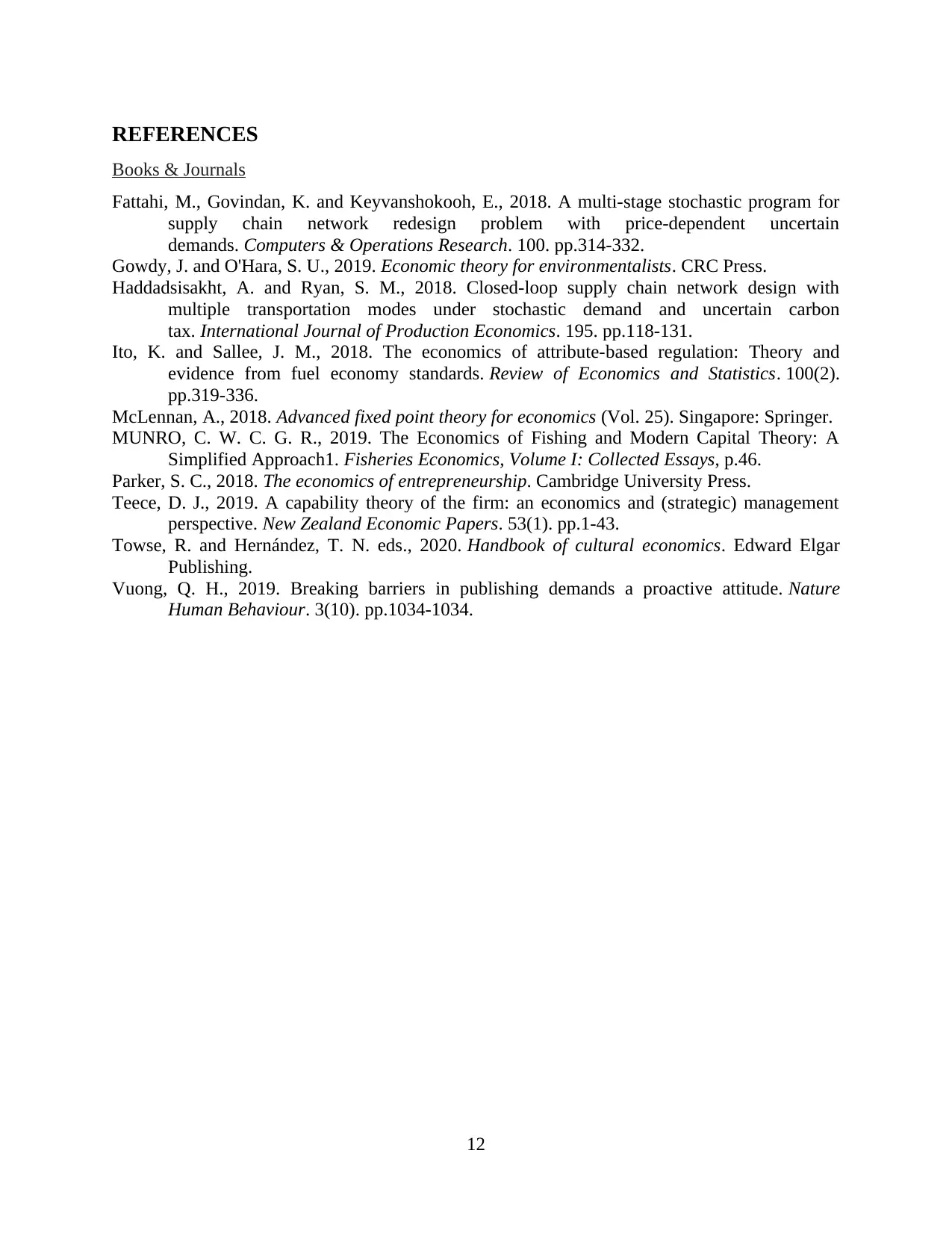
REFERENCES
Books & Journals
Fattahi, M., Govindan, K. and Keyvanshokooh, E., 2018. A multi-stage stochastic program for
supply chain network redesign problem with price-dependent uncertain
demands. Computers & Operations Research. 100. pp.314-332.
Gowdy, J. and O'Hara, S. U., 2019. Economic theory for environmentalists. CRC Press.
Haddadsisakht, A. and Ryan, S. M., 2018. Closed-loop supply chain network design with
multiple transportation modes under stochastic demand and uncertain carbon
tax. International Journal of Production Economics. 195. pp.118-131.
Ito, K. and Sallee, J. M., 2018. The economics of attribute-based regulation: Theory and
evidence from fuel economy standards. Review of Economics and Statistics. 100(2).
pp.319-336.
McLennan, A., 2018. Advanced fixed point theory for economics (Vol. 25). Singapore: Springer.
MUNRO, C. W. C. G. R., 2019. The Economics of Fishing and Modern Capital Theory: A
Simplified Approach1. Fisheries Economics, Volume I: Collected Essays, p.46.
Parker, S. C., 2018. The economics of entrepreneurship. Cambridge University Press.
Teece, D. J., 2019. A capability theory of the firm: an economics and (strategic) management
perspective. New Zealand Economic Papers. 53(1). pp.1-43.
Towse, R. and Hernández, T. N. eds., 2020. Handbook of cultural economics. Edward Elgar
Publishing.
Vuong, Q. H., 2019. Breaking barriers in publishing demands a proactive attitude. Nature
Human Behaviour. 3(10). pp.1034-1034.
12
Books & Journals
Fattahi, M., Govindan, K. and Keyvanshokooh, E., 2018. A multi-stage stochastic program for
supply chain network redesign problem with price-dependent uncertain
demands. Computers & Operations Research. 100. pp.314-332.
Gowdy, J. and O'Hara, S. U., 2019. Economic theory for environmentalists. CRC Press.
Haddadsisakht, A. and Ryan, S. M., 2018. Closed-loop supply chain network design with
multiple transportation modes under stochastic demand and uncertain carbon
tax. International Journal of Production Economics. 195. pp.118-131.
Ito, K. and Sallee, J. M., 2018. The economics of attribute-based regulation: Theory and
evidence from fuel economy standards. Review of Economics and Statistics. 100(2).
pp.319-336.
McLennan, A., 2018. Advanced fixed point theory for economics (Vol. 25). Singapore: Springer.
MUNRO, C. W. C. G. R., 2019. The Economics of Fishing and Modern Capital Theory: A
Simplified Approach1. Fisheries Economics, Volume I: Collected Essays, p.46.
Parker, S. C., 2018. The economics of entrepreneurship. Cambridge University Press.
Teece, D. J., 2019. A capability theory of the firm: an economics and (strategic) management
perspective. New Zealand Economic Papers. 53(1). pp.1-43.
Towse, R. and Hernández, T. N. eds., 2020. Handbook of cultural economics. Edward Elgar
Publishing.
Vuong, Q. H., 2019. Breaking barriers in publishing demands a proactive attitude. Nature
Human Behaviour. 3(10). pp.1034-1034.
12
⊘ This is a preview!⊘
Do you want full access?
Subscribe today to unlock all pages.

Trusted by 1+ million students worldwide
1 out of 12
Related Documents
Your All-in-One AI-Powered Toolkit for Academic Success.
+13062052269
info@desklib.com
Available 24*7 on WhatsApp / Email
![[object Object]](/_next/static/media/star-bottom.7253800d.svg)
Unlock your academic potential
Copyright © 2020–2025 A2Z Services. All Rights Reserved. Developed and managed by ZUCOL.



